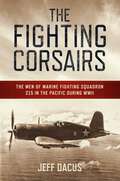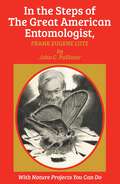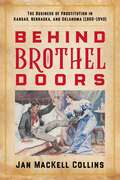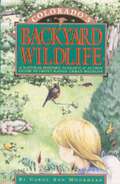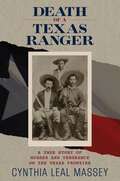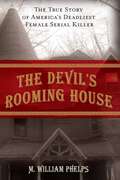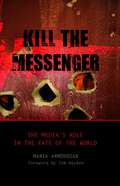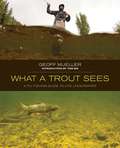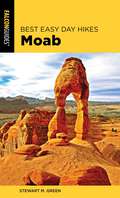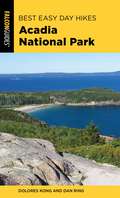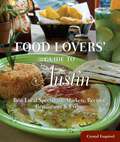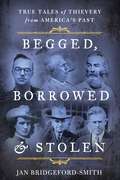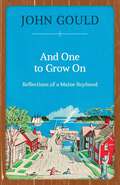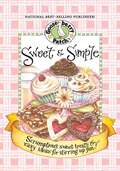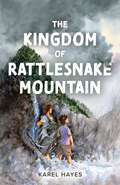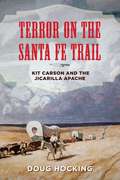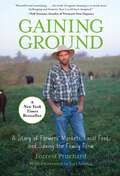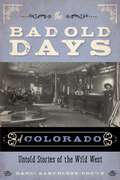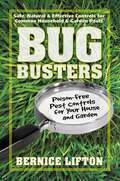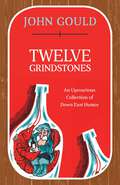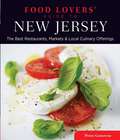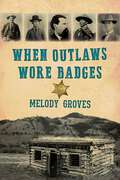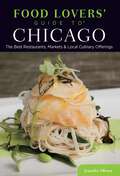- Table View
- List View
The Fighting Corsairs: The Men of Marine Fighting Squadron 215 in the Pacific during WWII
by Jeff DacusFrom an historian and columnist in Leatherneck and Armor magazines, this is the exciting, personal account of a Marine fighter squadron in the South Pacific during the critical days of 1943 when the tide turned against the Japanese. Based on individual interviews and wartime documents, this is a thrilling narrative of the Marines who lived, and died, during the toughest battles of the entire war. It looks at the war through the eyes of some of the greatest fighter pilots of all time, including Bob Hanson, the &“Maharajah of Rabaul&” and highest-scoring Corsair pilot in history.
In the Steps of The Great American Entomologist, Frank Eugene Lutz
by John C. PallisterFrank Eugene Lutz became an entomologist at a time when this science was still new. He was one of the first to set up experiments in the study of heredity using the common fruit fly. In his many field trips he observed unusual insects in their natural habitats and brought back thousands of valuable specimens. As curator of the Department of Entomology at the American Museum of Natural History, he was responsible for innovations in labeling and museum display. His observations of more than one thousand species found in his own back yard were the basis for his classic book, Lots of Insects. He set up the first nature trail in America; devising museum exhibits in natural outdoor settings.This first biography of one of the great American entomologists is filled with all the excitement that is to be found in the strange and infinite world of insects. Here is the fascinating story of Dr. Lutz&’s career along with a series of natured projects you can do at home that will help you observe insect behavior for yourself. Projects include: Bringing Insects to You, The Hows of Collecting, and Preserving and Mounting. While we already know much about insect life, much, much more remains to be learned. Even the amateur entomologist can make a contribution to science through their own research!
Behind Brothel Doors: The Business of Prostitution in Kansas, Nebraska, and Oklahoma (1860–1940)
by Jan MacKell CollinsOften overlooked, disregarded, or hidden from historical accounts due to its racy connotations, the prostitution industry was one of the most important factors in the development of the American West. The &“oldest profession&” fueled the economies of camps, towns, and cities as they grew.Sex workers, from common prostitutes to reigning madams such as Anna Wilson, Maggie Wood, and Big Ann Wynne, defied social norms to make sure their hometowns, and they themselves, were successful. Their reasons for entering the life varied, from women who could find no other way to make money to those who desired independence and wealth. In return they were ostracized, criticized, and subject to fines, jail, disease, drug addiction, violence, and unwanted pregnancies. While their success stories are many, others failed in their endeavors, their names buried with them when they died. Behind Brothel Doors chronicles the history of the nineteenth-century sex work industry in the Great Plains states of Kansas, Nebraska, and Oklahoma.
48 Hours Boston: Timed Tours For Short Stays
by Col. David WallaceNo time to research the many wonders of Boston? This pocketsize guide directs you to the main attractions of this remarkable and historic city, including many that are overlooked even by the seasoned Bostonian. With this resource in hand, you&’ll leave feeling you&’ve truly sensed the pulse of Boston.
Colorado's Backyard Wildlife: A Natural History, Ecology, & Action Guide to Front Range Urban Wildlife
by Carol Ann MoorheadIntroduces a variety of animals and habitats that exist along Colorado's Front Range. Ages 12 and up.
Death of a Texas Ranger: A True Story of Murder and Vengeance on the Texas Frontier
by Cynthia Leal MasseyDeath of a Texas Ranger is the thrilling, action-packed story of the murder of Texas Ranger John Green by Cesario Menchaca, one of three Rangers of Mexican descent under Green&’s command. Immediately word spread that the killing may have been the botched outcome of a contract taken out on Menchaca&’s life by the notorious Gabriel Marnoch, a local naturalist who had run up against the law himself. But was it? Much more than just a story about a tragic frontier killing, it is the story of an era. The events leading up to the murder and Green&’s son&’s decades&’ long quest for justice for his father&’s killer exemplify the chaotic frontier society in Texas after the Civil War, a time fraught with political turmoil and cultural clashes. Amidst that chaos, the virgin landscape of Texas was a magnet to those interested in the natural sciences in the nineteenth century, an era often referred to as the Age of Darwin. The clash between the seemingly pastoral landscape with its offerings for science and the brutal history of the region ties this very readable regional history into the larger American story.
Devil's Rooming House: The True Story of America's Deadliest Female Serial Killer
by M. William PhelpsThe gripping tale of a legendary, century-old murder spree***A silent, simmering killer terrorized New England in1911. As a terrible heat wave killed more than 2,000 people, another silent killer began her own murderous spree. That year a reporter for the Hartford Courant noticed a sharp rise in the number of obituaries for residents of a rooming house in Windsor, Connecticut, and began to suspect who was responsible: Amy Archer-Gilligan, who’d opened the Archer Home for Elderly People and Chronic Invalids four years earlier. “Sister Amy” would be accused of murdering both of her husbands and up to sixty-six of her patients with cocktails of lemonade and arsenic; her story inspired the Broadway hit Arsenic and Old Lace. The Devil’s Rooming House is the first book about the life, times, and crimes of America’s most prolific female serial killer. In telling this fascinating story, M. William Phelps also paints a vivid portrait of early-twentieth-century New England.
Kill the Messenger: The Media's Role in the Fate of the World
by Maria ArmoudianThis wide-ranging, insightful book will make readers keenly aware of the media's power, while underscoring the role that we all play in fostering a media climate that cultivates a greater sense of humanity, cooperation, and fulfillment of human potential. What role do the media have in creating the conditions for atrocities such as occurred in Rwanda? Conversely, can the media be used to preserve democracy and safeguard the human rights of all citizens in a diverse society? How will the media, now global in scope, affect the fate of the planet itself? The author explores these intriguing questions and more in this in-depth examination of the media's power to either help or harm. She begins by documenting how the media were used to spread a contagion of hate in three deadly conflicts: Rwanda, Nazi Germany, and the former Yugoslavia. She then turns to areas of the world where the media acted constructively-by aiding the peace process in Northern Ireland, rebuilding democracy in Chile, bridging ethnic divides in South Africa, improving the lot of women in Senegal, and boosting transparency and democratization in Mexico and Taiwan. Finally, she explains how the media interact with psychological and cultural forces to impact perceptions, fears, peer-pressure, "groupthink," and the creation of heroes and villains.
What a Trout Sees: A Fly-Fishing Guide to Life Underwater
by Geoff MuellerDo trout sleep? And if so, when? And how does that affect their feeding patterns? Does a rising or falling barometer affect feeding habits? How does refraction influence a fish&’s approach to a surface fly, human shadow, or false cast? How much do fish need to eat, under what conditions will they grow the largest?For the first time, an accessible, well-written title shows us what the world is like under the water, from the fish&’s perspective. Geoff Mueller, acclaimed senior editor with The Drake magazine, travels throughout some of the best trout habitat in America, talking with the experts and donning swim fins and mask to meet trout on their own turf. With What a Trout Sees, curious anglers interested in taking their skill levels up a notch or two will finally have all the information they need.
Best Easy Day Hikes Moab
by Stewart M. GreenBest Easy Day Hikes Moab includes concise descriptions and detailed maps for twenty easy-to-follow hikes in the desert parks as well as in the canyons near town. From renowned Arches National Park to secluded Dead Horse Canyon, these hikes, most less than 5 miles long, will fuel your desert hiking fever.
Best Easy Day Hikes Acadia National Park (Best Easy Day Hikes Series)
by Dolores Kong Dan RingBest Easy Day Hikes Acadia National Park includes concise descriptions and detailed maps for easy-to-follow hikes in an area of Maine that has long captivated artists, millionaires, generations of families, and even presidents. Stroll along Ocean Path to see the pink granite cliffs, blue skies, and white surf. From atop Cadillac Mountain, watch fog rolling in over Frenchman Bay below.Look inside for:• Casual hikes to longer adventures• Hikes for everyone, including families• Mile-by-mile directions and clear trail maps• Trail Finder for best hikes for views, children, dogs, and ocean lovers• GPS coordinates
Food Lovers' Guide to® Austin: Best Local Specialties, Markets, Recipes, Restaurants & Events (Food Lovers' Series)
by Crystal EsquivelSavor the Flavors of Austin Food Lovers’ Guide to Austin brings you the inside scoop on the best places to find, enjoy, and celebrate food. From family-owned taquerias and Tex-Mex restaurants to vegan and locally sourced options, as well as top-notch restaurants replete with impressive wine and cocktail lists, a bounty of mouthwatering delights awaits you in this engagingly written guide. With delectable regional recipes from the renowned kitchens of Austin’s iconic eateries, diners, and elegant dining rooms, Food Lovers’ Guide to Austin is the ultimate resource for food lovers to use and savor. Inside You'll Find: Food festivals and culinary events • Farmers’ markets, food trucks & food carts • Specialty food stores, markets, and producers • One-of-a-kind restaurants and landmark eateries • Recipes using local ingredients and traditions • The region’s best wineries and brewpubs • Cooking classes and a cocktail course
Begged, Borrowed, & Stolen: True Tales of Thievery from America's Past
by Jan Bridgeford-SmithBegged, Borrowed, & Stolen is a collection of true stories detailing the different icons, historical documents, art, patents, ideas, and more that have been stolen throughout US history. Drawing upon years of research and an extensive collection of photographs, the author sheds light on how land, art and treasures, ideas, and even bodies and elections were stolen from right under our noses!
Our Favorite Kid-Approved Recipes
by Gooseberry PatchWhether you've got budding chefs at home, or just hope to get your kids more involved at mealtime, Our Favorite Kid-Approved Recipes is here to help.You'll find over 60 kid-friendly recipes just perfect for beginning cooks. From simple (but delicious!) Ultimate Grilled Cheese Sandwiches and Baked French Fries to Pepperoni Pizza Breadsticks and Banana-Berry Smoothies, these recipes are sure to bring kids to the kitchen. There are after-school snacks, Saturday-morning breakfasts and even tasty dinners!When kids help at mealtime, their appetites are even better! Let them pick what's for dinner tonight!
And One to Grow On: Reflections of a Maine Boyhood
by John GouldWhen John Gould was young, a boy learned about the sea--and arithmetic and knots and geography and life--from the old deep-water men living out their lives in snug harbors. He grew up knowing the woods; the way a church supper smells; the way the Ladies Aid bargained together before a food sale. The friendly, close-knit community life and the deep family affection gave him a foundation of sound sense to last through the years ahead.This is a book to read and reread. You will be glad to know that once, in Maine, a boy could have this kind of childhood; and you might be envious because you did not.
Sweet & Simple Cookbook: Scrumptious sweet treats & easy ideas for stirring up fun!
by Gooseberry PatchA birthday cake with swirls of buttercream icing, frosty ice cream on a hot summer&’s day or warm, chocolatey cookies with a glass of ice-cold milk…it seems sweet treats are simply irresistible!We've gathered some of our yummiest recipes in Sweet & Simple along with lots of fun tips to make them extra-special. Why not host an oh-so-easy pie party? Just set up a table outside in the shade, fill pitchers with fresh lemonade and ask friends to bring a favorite pie to share…try Glazed Apple-Cream Pie, Caramel-Banana Pie or Fresh Peach Pie, each is delicious!Kids will love it when you set up an ice cream stand…scoops of Apple Dazzle, Frosty Peaches & Cream or Velvety Lime Squares will cool them down in a jiffy. And an old-fashioned cake walk will be a hit whatever the occasion when you show off Tutti-Fruitti Cake, Apple Blossom Cake or Toffee & Black Walnut Cake. Take a peek inside and whip up a special dessert tonight…it&’s easy as pie! Hardcover, 224 pages. (9-1/4" x 6-1/2")
The Kingdom of Rattlesnake Mountain
by Karel HayesThe exhilarating second book in acclaimed children's author Karel Hayes' Lake Kanakonda trilogy. Spring has come again to Lake Kanakondah, but it is not a peaceful spring. A menacing presence has invaded the deep dark waters of the bottomless lake. Caught in a mystery that began a long time ago in Peru, Alex, Maizy, and Harvey must right a wrong to save their lake. When Harvey disappears, Alex and Maizy find themselves fighting a dangerous force that plummets them spinning into an upside down world with no way home. With every step they take, the ancient mystery grows dangerously unsolvable, until Alex and Maizy are left wondering if they can right the wrong, find Harvey, and save Lake Kanakondah—and most important: find their way home?
Terror on the Santa Fe Trail: Kit Carson and the Jicarilla Apache
by Doug Hocking*Winner of the 2020 Will Rogers Medallion Award for Western Nonfiction*In the 1840s and 50s, the Jicarilla Apache were the terror of the Santa Fe Trail and the Rio Arriba. They repeatedly clashed with the cavalry and raided wagon trains, and there was bad blood between the band and the Army after the Battle of San Pasqual, when they were on opposite sides during the Mexican American War. In 1854, as traffic was on the increase along the historic trade route, the Jicarilla soundly defeated the 1st United States Dragoons in the Battle of Cieneguilla. Cieneguilla was the worst defeat of the US Army in the West up to that time, and it was just one of the first major battles between the US Army and Apache forces during the Ute Wars. According to one version of events, the 60 dragoons, under the direction of a Lt. Davidson, had engaged in an unauthorized attack on theJicarilla while they were out on patrol. Others claimed that the Jicarilla either ambushed the Army or taunted them into attack. Kit Carson, who was agent for the Jicarilla, would defend Davidson&’s actions—and after this fight, he served as a scout against the Jicarilla. Much like the Sioux defeat of Custer at Little Big Horn, the Jicarilla&’s victory over the Army led to retribution and disaster. The Jicarilla were defeated and faded from memory before the Civil War. These are the events that brought them to ruin.
Gaining Ground: A Story of Farmers' Markets, Local Food, and Saving the Family Farm
by Forrest PritchardWith humor and pathos, Forrest Pritchard recounts his ambitious and often hilarious endeavors to save his family’s seventh-generation farm in the Shenandoah Valley. Through many a trial and error, he not only saves Smith Meadows from insolvency but turns it into a leading light in the sustainable, grass-fed, organic farm-to-market community. There is nothing young Farmer Pritchard won’t try. Whether he’s selling firewood and straw, raising free-range chickens and hogs, or acquiring a flock of Barbados Blackbelly sheep, his learning curve is steep and always entertaining. Pritchard’s world crackles with colorful local characters—farm hands, butchers, market managers, customers, fellow vendors, pet goats, policemen—bringing the story to warm, communal life. His most important ally, however, is his renegade father, who initially questions his son's career choice and eschews organic foods for the generic kinds that wreak havoc on his health. Soon after his father’s death, the farm becomes a recognized success and Pritchard must make a vital decision: to continue serving the local community or answer the exploding demand for his wares with lucrative Internet sales and shipping deals. More than a charming story of honest food cultivation and farmers’ markets, Gaining Ground tugs on the heartstrings, reconnecting us to the land and the many lives that feed us.
The Bad Old Days of Colorado: Untold Stories of the Wild West
by Randi Samuelson-BrownFINALIST FOR THE 2021 COLORADO BOOK AWARDThe Bad Old Days of Colorado celebrates the state&’s glorious and rowdy past. Many people born and bred here relish just how &“bad&” things used to be: the terrain, the inhabitants and especially the quality of whiskey. It almost goes without saying that Colorado had all the characteristic Wild West elements—and in abundance! The chapters focus on the infamous and notorious rather than the law-abiding and civic-minded settlers. These pages, like the state, recount the tales of people who came West seeking, if not their fortune, at least opportunity. It is no secret that Colorado was settled by the adventurous willing to brave the harsh conditions and to prevail. Whether on the right or the wrong side of the law, all settlers and pioneers made unique contributions to the state&’s complex culture. Certainly, in the nineteenth century, Colorado was not for the faint of heart.
Bug Busters
by Bernice LiftonWant to get rid of pesky bugs and rodents in and around your home and garden—without using dangerous chemical pesticides? Bug Busters provides dozens of environmentally safe, easy methods for keeping your home free of pests. Written in easy-to-understand language, this book combines traditional time-proven pest controls with the latest research. Also included are new and innovative techniques for eradicating vermin. And for those times when a chemical pesticide or exterminator may be your only recourse, as with termite infestation, Bug Busters tells you how to find a competent professional and how to properly handle and dispose of chemical pesticides.At a time when literally thousands of adults and children are treated yearly for pesticide mishaps, Bug Busters provides important information for anyone who is concerned with safe and intelligent pest control.
Twelve Grindstones: An Uproarious Collection of Down East Folklore
by John GouldTwelve Grindstones continues the laughter and wisdom, the leg-pulling and the literate chuckling of John Gould. Starting down the road to hilarity, there are some old stories and some new stories, all of them great stories from the canon of Maine folklore. Within are some long and some tall tales about blueberry picking, railroading, wood buying, lobster wars, and bootlegging.So sit down and put your feet up and prepare for some of the most amusing, preposterous, and heartwarming tales you&’ve likely heard in a very long time. You&’re in for a treat.
Food Lovers' Guide to® New Jersey: The Best Restaurants, Markets & Local Culinary Offerings (Food Lovers' Series)
by Peter GenoveseSavor the flavors of New Jersey If there is one thing New Jerseyans are good at, it&’s eating. We&’re equally at home in the poshest restaurant and the most ramshackle seafood shack. We can describe the virtues of filet mignon or a chili cheese dog. We&’ll think nothing of driving 50 miles or more to our favorite restaurant. The Garden State? Call it the Food Fanatic State.In Food Lovers&’ Guide to New Jersey, seasoned food writer Peter Genovese shares the inside scoop on the best places to find, enjoy,and celebrate these culinary treasures. A bounty of mouthwatering delights awaits you in this engagingly written guide.With delectable recipes from the renowned kitchens of the state&’s iconic eateries, diners, and elegant dining rooms, Food Lovers&’ Guide to New Jersey is the ultimate resource forfood lovers to use and savor. Inside You'll Find: Favorite restaurants and landmark eateries • Specialty food stores and markets • Farmers&’ markets and farm stands • Food festivals and culinary events • Recipes from top New Jersey chefs • The state&’s best cafes, taverns, and wine bars • Cooking classes • Local food lore and kitchen wisdom
When Outlaws Wore Badges
by Melody Groves**Winner of the 2021 New Mexico-Arizona Book Awards (History, Other)**Lawman or Outlaw?At times, the black-hatted &“villains&” and white-hatted &“good guys&” of the Old West were one and the same. Often it was difficult, if not impossible, to distinguish who was who. Sheriff Wyatt Earp stole horses and ran brothels. Albuquerque&’s first town marshal, Milton Yarberry, was accused of murder and subsequently &“jerked to Jesus.&” Burt Alvord, town marshal of Willcox, Arizona, and friends, robbed a train. Alvord then deputized these same friends into a posse to apprehend the robbers. It came as no surprise when his posse came up empty handed. Justice Hoodoo Brown and Deputy JJ Webb ruled Las Vegas as leaders of the Dodge City Gang until they were run out of town by citizens fed up with their type of justice. &“Mysterious&” Dave Mather and even two of the Dalton Gang spent time behind a badge, as well as behind bars.When Outlaws Wore Badges explores the double lives of outlaw lawmen through some of the West&’s most memorable frontier characters.
Food Lovers' Guide to® Chicago: The Best Restaurants, Markets & Local Culinary Offerings (Food Lovers' Series)
by Jennifer OlveraThe ultimate guide to Chicago's food scene provides the inside scoop on the best places to find, enjoy, and celebrate local culinary offerings. Written for residents and visitors alike to find producers and purveyors of tasty local specialties, as well as a rich array of other, indispensable food-related information including: food festivals and culinary events; specialty food shops; farmers&’ markets and farm stands; trendy restaurants and time-tested iconic landmarks; and recipes using local ingredients and traditions. This second edition is fully updated and revised.
